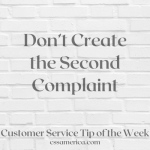
Admit it. You thought about it. You thought:
Why in the world did the customer try to assemble that before reading the instructions? Why would they drive all the way down here instead of just checking the website? Why would they go through the drive-thru when they can deposit using their phone? Is this customer crazy? I’ve told them 3 times what they need to do to buy this ticket, and they still can’t figure it out!
Sometimes our customers seem crazy. Sometimes they don’t seem like the sharpest tool in the shed. Sometimes what they do or don’t do makes little sense to us. But the reason why we feel that way is often based on looking at things through our lens instead of their lens. Maybe it’s our hundreds and hundreds of similar experiences with similar customers that can leave us jaded, with a negative perspective of our customers.
To deliver a positive customer service experience, we need to have a positive mindset of our customers. But how do we reframe our mental picture of the customer? How do we retrain our brains to look at them and their situations differently?
Creating a Positive Habit
If it takes 21 days for something to become a habit, then we’re going to give you some intentional questions to ask yourself day after day if you find yourself rolling your eyes about your customers or viewing them in a negative light:
- Instead of focusing on what the customer did wrong, ask yourself: What did the customer do right?
- Instead of thinking a process is so simple, ask yourself: Was this a piece of cake the first time it was explained to me?
- Instead of getting frustrated for having to explain steps multiple times, stop and ask yourself: Can the customer explain this to me? By asking the customer to walk you through the steps this time, you can figure out what they understand and what they don’t understand.
These are the 3 questions to ask yourself when you feel that frustration boiling or those eyes rolling: What did the customer do right? Was this a piece of cake the first time it was explained to me? Can the customer explain this to me?
What you’re doing with these 3 simple questions is you’re (1) Thinking about something positive the customer has done (2) Trying to be a little empathetic, and (3) Better understanding your customer by becoming more of a listener, less of a talker.
Retrain your brain to reframe your picture of your customers.
Signup for FREE Tips! Contact Us More Resources for You Visit Our Home Page























